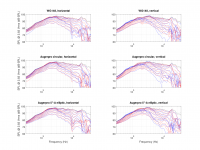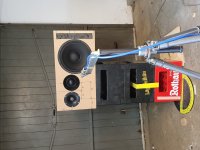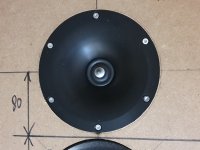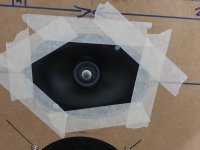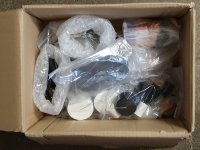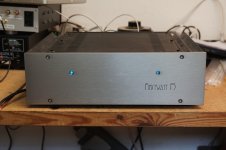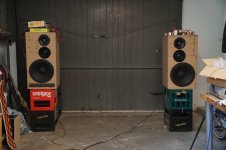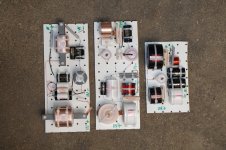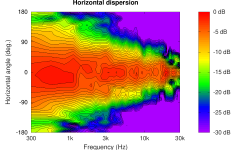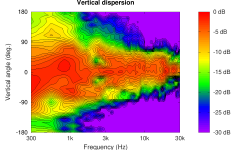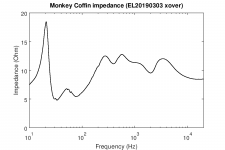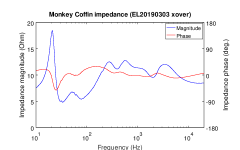Ok, this was a long break. I have done a bit on wood working and ordered x-over parts for the second prototype (Mundorf seem to be out of stock, though).
The CNC shop also sent me a bunch of circular augerpro* waveguides that fit the Scan Speak tweeter. There are now three waveguide candidates for the Monkey Coffin (1 :
- The WG148, which I used until now in the Monkey Coffin design. The WG148 is a cheap plastic part, but it works very well. The issue with the stock WG148 is that it does not fit the Scan R2904 tweeter. I managed to modify the WG148 to match the Scan tweeter, but it's not so easy.
- The augerpro* circular Scan waveguide. This is the same diameter as the WG148 and almost the same depth. It fits the R2904 Scan tweeter like a glove.
- The augerpro* 5" version A. This elliptical waveguide theoretically allows mounting the tweeter a bit closer to the midrange driver. However, the magnet of the midrange driver used in the Monkey Coffin is so big that this does not work.
(*Augerpro designs superb waveguides and publishes the 3D files for them. Simply send these files to a 3D CNC service and off you go! I used 3Dhubs.com, and they were great.)
I made a few measurements comparing these three waveguides (results in the the attachment):
- Scan R204 tweeter in waveguide, mounted in the Monkey Coffin baffle
- Anechoic measurements: on-axis and off-axis at 10° increments (-90° to +90°), both horizontally and vertically
- Microphone 100cm away from the baffle surface. Rotation axis was on baffle surface, passing through the x/y center of the tweeter
- Red curves: "inside" (horizontal) or "upwards" (vertical), blue curves: "outside" (horizontal) or "downwards" (vertical), black curve: on-axis
As I see it, the circular augerpro waveguide performs pretty much the same as the WG148. It will therefore work in the Monkey Coffin design as it is, without any modifications to the x-over. This is not surprising, since the dimensions are identical to the WG148. The elliptic waveguide is also good, but slightly different above 8 kHz or so.
Given the aim that the Monkey Coffin should be easy to make on a kitchen table, the circular augerpro waveguide seems to be a good replacement for the WG148, which requires difficult modification. Flush mounting the elliptical waveguide is a bit more difficult, beause it's not so easy to make the cut-out with a router. Oh, and CNC parts look so much better than the cheap plastic WG148!
The CNC shop also sent me a bunch of circular augerpro* waveguides that fit the Scan Speak tweeter. There are now three waveguide candidates for the Monkey Coffin (1 :
- The WG148, which I used until now in the Monkey Coffin design. The WG148 is a cheap plastic part, but it works very well. The issue with the stock WG148 is that it does not fit the Scan R2904 tweeter. I managed to modify the WG148 to match the Scan tweeter, but it's not so easy.
- The augerpro* circular Scan waveguide. This is the same diameter as the WG148 and almost the same depth. It fits the R2904 Scan tweeter like a glove.
- The augerpro* 5" version A. This elliptical waveguide theoretically allows mounting the tweeter a bit closer to the midrange driver. However, the magnet of the midrange driver used in the Monkey Coffin is so big that this does not work.
(*Augerpro designs superb waveguides and publishes the 3D files for them. Simply send these files to a 3D CNC service and off you go! I used 3Dhubs.com, and they were great.)
I made a few measurements comparing these three waveguides (results in the the attachment):
- Scan R204 tweeter in waveguide, mounted in the Monkey Coffin baffle
- Anechoic measurements: on-axis and off-axis at 10° increments (-90° to +90°), both horizontally and vertically
- Microphone 100cm away from the baffle surface. Rotation axis was on baffle surface, passing through the x/y center of the tweeter
- Red curves: "inside" (horizontal) or "upwards" (vertical), blue curves: "outside" (horizontal) or "downwards" (vertical), black curve: on-axis
As I see it, the circular augerpro waveguide performs pretty much the same as the WG148. It will therefore work in the Monkey Coffin design as it is, without any modifications to the x-over. This is not surprising, since the dimensions are identical to the WG148. The elliptic waveguide is also good, but slightly different above 8 kHz or so.
Given the aim that the Monkey Coffin should be easy to make on a kitchen table, the circular augerpro waveguide seems to be a good replacement for the WG148, which requires difficult modification. Flush mounting the elliptical waveguide is a bit more difficult, beause it's not so easy to make the cut-out with a router. Oh, and CNC parts look so much better than the cheap plastic WG148!
Attachments
Last edited:
Always exiting moment, hopefully with good results. This is the first time a stereo set then.
I would not be surprised it wil give other impressions than a mono speaker.
Short summary: no (bad) surprises!
I finished building the second prototype. Since I didn't have a stereo amp in the workshop, I went to the basement and came back with an old class-D amp that refuses to die, no matter badly it is treated. That's always good to have in the workshop. I hooked everything up and listened to some music. Sound was good, but... well, is that everything!?
After a while I went back to the basement and came back with an F5 that was built by Nelson Pass himself. I guess that should do in terms of street credibility. And no, what came out of the Monkey Coffins with the class-D amp was not everything. I never heard my F5 as good as this!
Don't hold your breath for more measurements and data. I am busy with listening to music, even though the acoustics of my workshop are not exactly great (I tried using the skateboard as a diffuser, but no luck
Attachments
Last edited:
Good progress!
What are the findings now if you compare the stereo with the earlier mono setup? Are the timbre and tonal balance still ok? I think it could be different.
Like you are mentioning also, you need a good listening environment and set for the final tuning now.
Timbre and tonal balance is pretty much the same as with the mono setup.
I am amazed how much of a difference I could hear between the two amps. I knew the F5 sounds different (better) than the old class-D, but I never heard it so much. I guess these speakers are quite revealing. And they do really well with a smallish amp like the F5.
Good morning,
I'm following this project since the begining, I would be interested in building a pair of these, but im waiting for some more info to participate in the GB. Maybe its a bit too early for the waveguide gb ?
Things like driver list, XO components list, etc. I guess this is coming up at some time ? And of course the construction plans 😏
Thanks to all for your efforts!
Charles
I'm following this project since the begining, I would be interested in building a pair of these, but im waiting for some more info to participate in the GB. Maybe its a bit too early for the waveguide gb ?
Things like driver list, XO components list, etc. I guess this is coming up at some time ? And of course the construction plans 😏
Thanks to all for your efforts!
Charles
Good morning,
I'm following this project since the begining, I would be interested in building a pair of these, but im waiting for some more info to participate in the GB. Maybe its a bit too early for the waveguide gb ?
Things like driver list, XO components list, etc. I guess this is coming up at some time ? And of course the construction plans ��
Thanks to all for your efforts!
Charles
Well, the group buy can be repeated at any time. Or you can just order the waveguides directly.
You are right that documentation is not yet very well developed. You can take a look at the current documentation here.
Some quick pointers:
- The current box dimensions are slightly different than shown on the earlier drawing, because it does not have the bass reflex port on the front. I do have an updated drawing, but I need to double check this. I'll post it once I think it's right.
- Drivers: tweeter = Scan Speak R2904 / midrange: Volt VM752 / woofer: Faital 12PR320
- The documentation linked above shows the current version of the x-over (elliptic filters), including a detailed parts list
So you now have two 5" holes stacked. If you add a 5" flared port above , it would be three!
More of a floor stander I guess. An Elf Coffin?
Yup. However, the design targets explicitly require a monkey. An elf is not allowed.
I measured the polar response of the Monkey Coffin as it is now (augerpro circular waveguide, x-over with elliptic filters EL20190303 version). SPL response measurements on horizontal and vertical orbits, at 10° steps from -180° to +180°. The microphone was positioned 100 cm from the baffle, height between the tweeter and midrange. Rotation axes through the horizontal and vertical center of the tweeter and midrange.
The attached results show rather smooth dispersion. I am pretty happy with it. If you are not familiar with dispersion plots (polar plots), the GedLee paper "Directivity in Loudspeaker Systems" is a good read!
As always, the priority is on the horizontal dispersion (we are in the stereo / left-right world). The horizontal dispersion is as clean as it gets.
As expected with conventional multi-way speakers, the vertical dispersion shows an artifact at the x-over frequency between the midrange and the tweeter. However, the rather steep elliptic filters make sure this artifact is limited to a very narrow band, and the overall vertical response looks better than the horizontal dispersion of many other speakers.
It seems the waveguides and the steep elliptic filters work out pretty well!
The attached results show rather smooth dispersion. I am pretty happy with it. If you are not familiar with dispersion plots (polar plots), the GedLee paper "Directivity in Loudspeaker Systems" is a good read!
As always, the priority is on the horizontal dispersion (we are in the stereo / left-right world). The horizontal dispersion is as clean as it gets.
As expected with conventional multi-way speakers, the vertical dispersion shows an artifact at the x-over frequency between the midrange and the tweeter. However, the rather steep elliptic filters make sure this artifact is limited to a very narrow band, and the overall vertical response looks better than the horizontal dispersion of many other speakers.
It seems the waveguides and the steep elliptic filters work out pretty well!
Attachments
Looks quite good Matthias! As expected also, because we have done a lot of studies to make it good.
Yes, the good vertical dipersion is the advantage of the steep elliptical filtering and one of the reasons I did make also this filter proposal. The overlap region is small, which reduces the vertical dispersion artifacts. Remark also that your plot is measured at one vertical position. In the full space it is spread out more in a way the room power is not affected in a narrow frequency band.
If the sound is ok also, I think this is a good design. Do you have received also a second opinion about the sound? Not that I have my doubts about your opinion about it , but it gives an extra confirmation.
, but it gives an extra confirmation.
Maybe some people will built the Monkey Coffin and they will give their experiences also probably.
Yes, the good vertical dipersion is the advantage of the steep elliptical filtering and one of the reasons I did make also this filter proposal. The overlap region is small, which reduces the vertical dispersion artifacts. Remark also that your plot is measured at one vertical position. In the full space it is spread out more in a way the room power is not affected in a narrow frequency band.
If the sound is ok also, I think this is a good design. Do you have received also a second opinion about the sound? Not that I have my doubts about your opinion about it
Maybe some people will built the Monkey Coffin and they will give their experiences also probably.
Yeah, I'll try to get an opinion from some other guys.
In the meantime, here's the impedance curve of the Monkey Coffin with the elliptic filter (version EL20190303). Depending on how you interpret the meaning of the "8 Ohm rating", we may have slightly scraped past the "8 Ohm" design target (no surprise here, we already knew this when we started designing the the x-over). Amps with very low damping factors might produce a wee bit more bass . Above 100 Hz, the "8 Ohm" requirement is ok. There are no nasty dips or peaks that would cause trouble with "weak amps".
. Above 100 Hz, the "8 Ohm" requirement is ok. There are no nasty dips or peaks that would cause trouble with "weak amps".
In the meantime, here's the impedance curve of the Monkey Coffin with the elliptic filter (version EL20190303). Depending on how you interpret the meaning of the "8 Ohm rating", we may have slightly scraped past the "8 Ohm" design target (no surprise here, we already knew this when we started designing the the x-over). Amps with very low damping factors might produce a wee bit more bass
Attachments
Industry standard is that minimum impedance should not go bellow 80% percent of declared value. For 4 ohm loudspeaker minimum allowed impedance is 3.2 ohm and for 8 ohm loudspeaker it is 6.4 ohm - for the manufacturers that don't lie in their specs.
It should actually be impedance in relation to phase angle to be able to discern if it presents heavy load for amplifier at some frequencies or not.
It should actually be impedance in relation to phase angle to be able to discern if it presents heavy load for amplifier at some frequencies or not.
Last edited:
Industry standard is that minimum impedance should not go bellow 80% percent of declared value.
I thought so, too. However, I could not find a water proof reference of this standard. I also remember reading that the impedance rating should include the relevant frequency band (e.g, "8 Ohm from 100 Hz and up").
It should actually be impedance in relation to phase angle to be able to discern if it presents heavy load for amplifier at some frequencies or not.
You are right. Plot including phase is attached.
Attachments
Last edited:
- Home
- Loudspeakers
- Multi-Way
- Open Source Monkey Box
